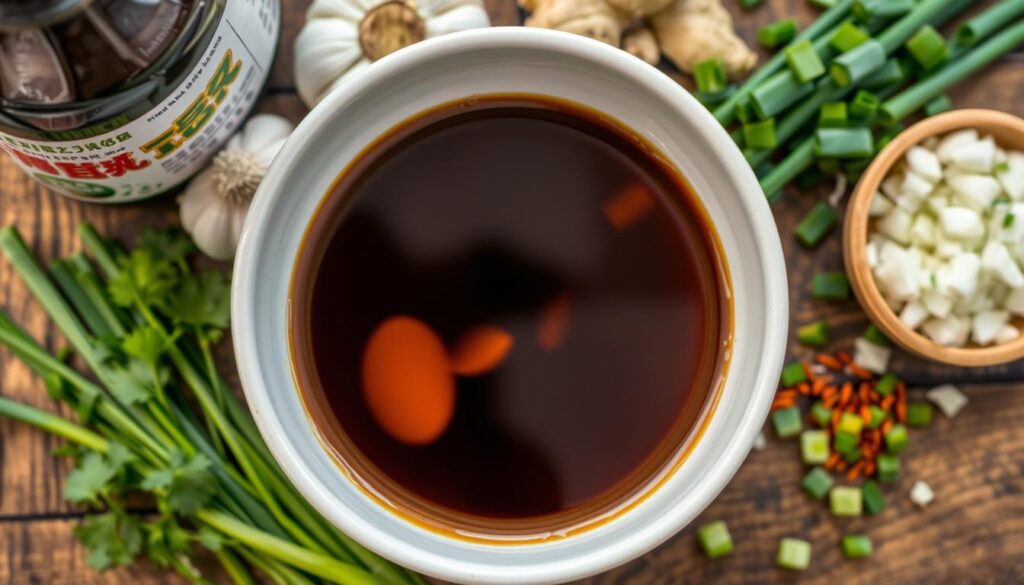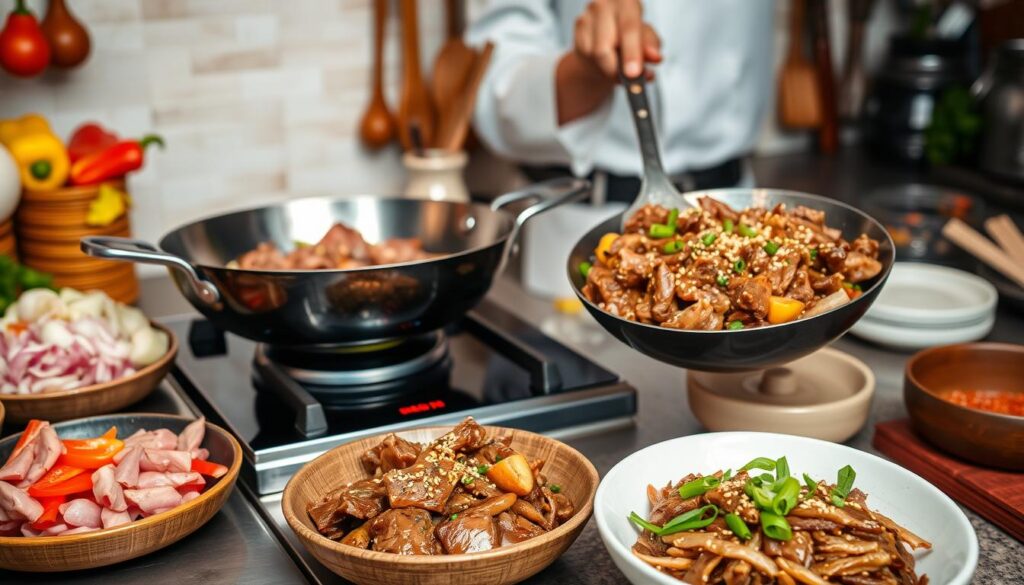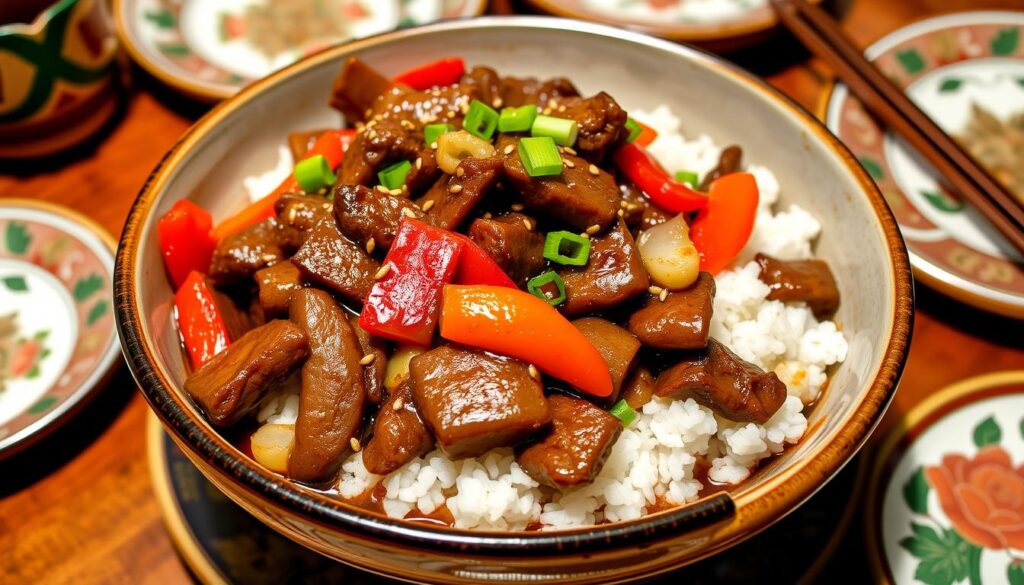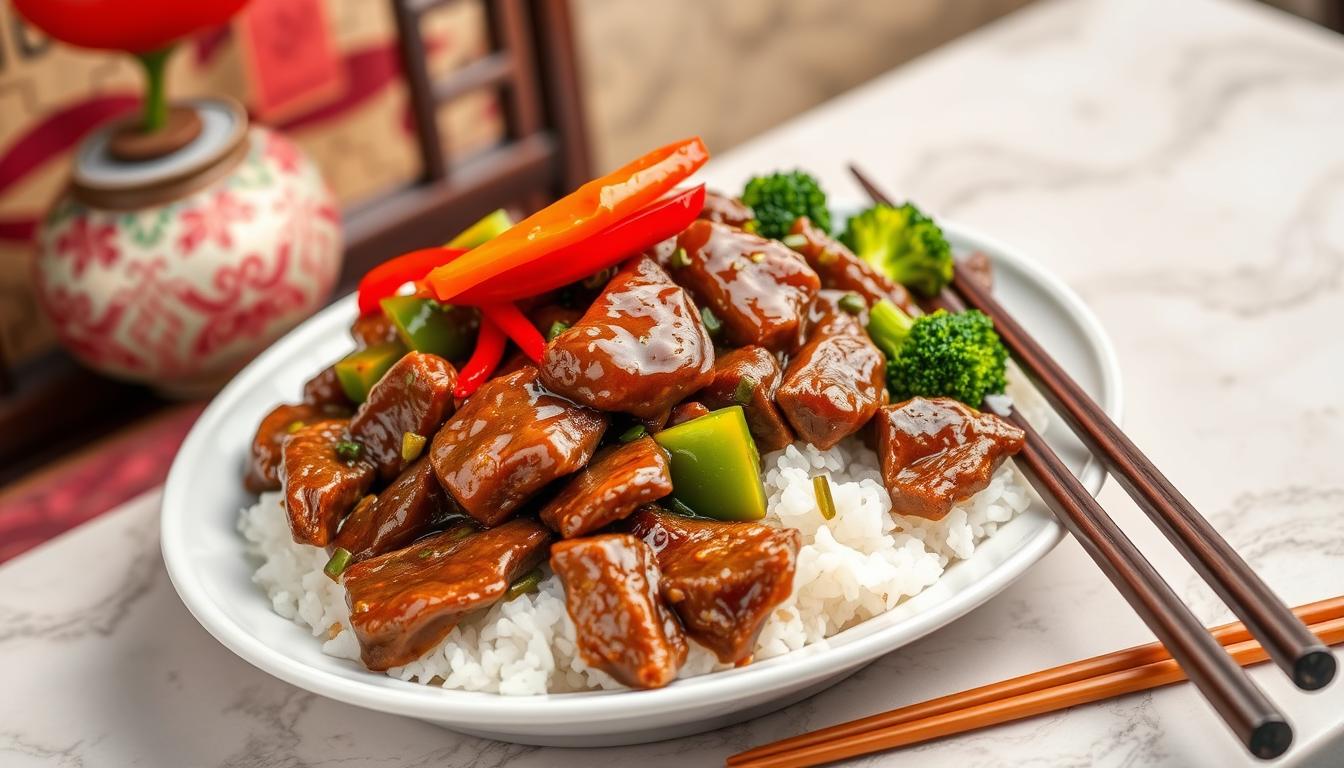Ready to explore the flavors of China? The authentic Beijing beef recipe is waiting for you. To make this dish, you need to know its history and cultural importance. You’ll also need the right ingredients.
Whether you’re a pro in the kitchen or just starting, this guide has you covered. You’ll learn about Beijing beef’s origins, the ingredients you need, and how to prepare it. We’ll show you how to make this tasty Chinese dish with ease.
Introduction to Beijing Beef
In this article, you’ll dive into the world of Beijing🍖beef. You’ll learn how to make it easily. From its history to the ingredients you need, we’ve got you covered.
- Learn the history and cultural significance of beijing🍖beef
- Discover the necessary beijing🍖beef ingredients for an authentic beijing beef recipe
- Get a step-by-step guide on how to prepare beijing🍖beef
- Understand the importance of using the right beijing🍖beef ingredients
- Learn how to make the best beijing🍖beef with ease
- Explore the origins of beijing🍖beef and its evolution over time
The Origin Story of Beijing Beef
Exploring Chinese cuisine, you’ll find Beijing🍖beef has a deep history. It started in the Qing dynasty in Northern China. The dish was a stir-fry with beef, veggies, and a sweet sauce.
To make a true Chinese Beijing🍖beef recipe, knowing its history is key.
Beijing🍖beef is more than food; it’s a cultural experience. It brings people together. Over time, the dish has changed, but its core remains the same.
Historical Roots in Northern Chinese Cuisine
The roots of Beijing🍖beef go back to the Qing dynasty’s imperial kitchens. It was a royal favorite. As it spread, local ingredients and methods made it unique in each region.
Evolution of the Modern Beijing🍖Beef
Today, Beijing🍖beef is a key part of Chinese food. It has evolved from traditional stir-fries to modern dishes. Cooking Beijing🍖beef at home or trying it out is a memorable experience.
Cultural Significance in Chinese Dining
In Chinese culture, Beijing🍖beef is for special events like weddings. It symbolizes prosperity and good luck. Learning to make Beijing🍖beef lets you share its rich history and cultural value with others.
Essential Ingredients for Authentic Beijing Beef
To make authentic Beijing🍖beef, you need a few key ingredients. These include thinly sliced beef, vegetables, and a sweet, savory sauce. It’s important to use high-quality beef, like flank steak or ribeye, for the best taste.
The vegetables in Beijing🍖Beef are bell peppers, onions, and snow peas. They add crunch and flavor. The sauce, made from soy sauce, hoisin sauce, and sugar, gives the dish its unique taste. Using the right ingredients is key to making authentic Beijing🍖beef.
Here are the main ingredients for your Beijing🍖Beef recipe:
- Thinly sliced beef (flank steak or ribeye)
- Bell peppers
- Onions
- Snow peas
- Soy sauce
- Hoisin sauce
- Sugar
With these ingredients, you can make a delicious, authentic Beijing🍖beef dish. It will impress your family and friends. Make sure to choose the right ingredients for the best flavor and texture.
Selecting and Preparing Your Beef Cut
To make delicious Beijing🍖Beef, you need to pick the right beef cut. The best cuts are tender and lean, like flank steak or ribeye. It’s key to choose a cut that cooks evenly and quickly.
After picking your beef, slice it thinly against the grain. This makes the beef cook evenly and quickly. Here are some tips:
- Slice the beef into thin strips, about 1/4 inch thick.
- Cut against the grain to ensure tenderness.
- Use a sharp knife to prevent tearing the meat.
After slicing, you can tenderize the beef. You can marinate it in soy sauce, garlic, and ginger. Or, use a meat tenderizer tool. These methods help the beef cook perfectly.
The secret to great Beijing🍖Beef is using quality ingredients and quick, even cooking. With practice and patience, you’ll make a dish that’s both tasty and authentic. Learning to make Beijing🍖Beef is a great way to improve your cooking skills.
| Beef Cut | Tenderizing Method | Cooking Time |
|---|---|---|
| Flank Steak | Marinating | 10-12 minutes |
| Ribeye | Meat Tenderizer Tool | 8-10 minutes |
The Perfect Beijing Beef Marinade
To make an authentic Beijing🍖beef recipe, marinating the beef is key. The marinade mixes soy sauce, hoisin sauce, and sugar. This blend tenderizes the beef and adds flavor.
Here are some key ingredients for your marinade:
- Soy sauce: provides a salty, umami flavor
- Hoisin sauce: adds a sweet and savory flavor
- Sugar: balances out the savory flavors
- Ginger and garlic: add a punch of flavor and aroma
The marinade is what makes Beijing beef special. By using these ingredients, you’ll make a delicious and authentic dish. 
To marinate your beef perfectly, let it sit for at least 30 minutes. This allows the flavors to soak into the meat. Your Beijing🍖beef will be tender, flavorful, and unforgettable. With this marinade, you’re on your way to making a dish that will impress everyone.
Master Sauce Components and Preparation
To make a real Chinese Beijing🍖beef recipe, focus on the sauce. It’s key to this dish. The sauce includes soy sauce, hoisin sauce, and sugar. It’s important to mix the sweet and savory flavors just right.
Here are some key points to consider when making the sauce:
- Use high-quality beijing🍖beef ingredients, such as fresh ginger and garlic, to add depth to the sauce.
- Adjust the amount of sugar and soy sauce to balance the sweet and savory flavors.
- Simmer the sauce for a few minutes to thicken it and enhance the flavors.
By following these tips, you can make a delicious and authentic Chinese Beijing🍖beef recipe. It will impress your family and friends. Remember to use the right ingredients and balance the flavors in the sauce.
Here is a simple table to help you understand the key components of the sauce:
| Ingredient | Quantity | Purpose |
|---|---|---|
| Soy sauce | 2 tablespoons | Adds savory flavor |
| Hoisin sauce | 1 tablespoon | Adds sweet and savory flavor |
| Sugar | 1 teaspoon | Balances the flavors |
By mastering the sauce components and preparation, you can create a delicious and authentic Chinese Beijing🍖beef recipe. It will become a staple in your kitchen.
Step-by-Step Beijing Beef Cooking Method
To make Beijing🍖beef, you need to know how to cook it. This dish is best cooked in a wok or large skillet over high heat. Stir-frying the ingredients quickly is key to avoid burning.
Start by heating your wok or skillet over high heat and add a bit of oil. Then, add your beef and cook until it’s browned, about 3-4 minutes. Next, add your vegetables, like bell peppers and onions, and stir-fry for 2-3 minutes.
Lastly, add your sauce and stir-fry for another minute. This will make the sauce thicken and coat the ingredients well.
When cooking Beijing🍖beef, use high-quality ingredients. Choose fresh vegetables and tender beef. Stir-frying quickly helps prevent burning. You can also add your favorite vegetables or sauces to make it your own.

For the best results, practice your stir-frying skills. Try different ingredients and sauces. With patience and practice, you can make delicious Beijing beef at home.
Essential Wok Techniques for Beijing Beef
To make perfect beijing beef, you must learn key wok techniques. Cooking in a wok takes skill, but with practice, you can make an authentic beijing beef recipe as good as your favorite Chinese restaurant.
It’s important to control your wok’s temperature. It should be hot but not too hot. Heat the wok over high heat for a few minutes, then lower it to medium-high. This helps sear the beef without burning it.
Stir-Frying Fundamentals
Stir-frying is an art that needs practice. Stir the ingredients constantly with a gentle, sweeping motion. This ensures even heat and prevents burning.
Timing and Movement Tips
Timing is key in stir-frying. Add ingredients in the right order for perfect cooking. Start with the beef, then the vegetables, and finish with the sauce. Stir gently and add oil if it gets too dry.
By mastering these wok techniques, you’ll make an authentic beijing beef recipe that will wow your family and friends. Remember, practice makes perfect, so don’t get discouraged if it takes a few tries.
| Ingredient | Quantity |
|---|---|
| Beef | 1 lb |
| Vegetables | 1 cup |
| Sauce | 1/4 cup |
Common Mistakes to Avoid When Making Beijing Beef
Learning to make Beijing beef can be tricky. One common mistake is overcooking the beef. This makes it tough and dry. To fix this, cook the beef just right and use a thermometer to check its temperature.
Another mistake is not getting the flavors right in the sauce. For spicy Beijing beef, balance sweet, sour, and savory tastes. Adjust the soy sauce, vinegar, and sugar to get it just right. Remember, the key to a great Beijing beef dish is in the sauce.
Here are some additional tips to keep in mind:
- Use the right cut of beef, such as flank steak or sirloin, for the best results.
- Don’t over-marinate the beef, as this can make it too salty.
- Stir-fry the beef and vegetables quickly over high heat to preserve their texture and flavor.
By following these tips and avoiding common mistakes, you’ll be well on your way to making delicious Beijing beef. Whether you prefer spicy Beijing beef or a milder version, the key is to practice and experiment until you find the perfect balance of flavors.

With patience and practice, you’ll master the art of making Beijing beef and enjoy this popular Chinese dish in the comfort of your own home. So, go ahead and give it a try, and don’t be afraid to experiment with different ingredients and flavors to create your own unique version of how to make Beijing beef.
Serving Suggestions and Accompaniments
There are many ways to serve your savory Beijing beef. You can choose classic side dishes or try something new. For a traditional meal, pair your beef with steamed rice, stir-fried veggies, or egg rolls.
A chinese beijing beef recipe needs the right sides. Here are some favorites:
- Steamed dumplings
- Stir-fried noodles
- Egg drop soup
For a modern twist, try noodles, salads, or a beef wrap. The goal is to mix flavors and textures well. A bit of creativity can make your meal unforgettable.
To make your dish look great, add garnishes like green onions or sesame seeds. Serving it in a decorative bowl or on a platter adds elegance.
Conclusion: Mastering Your Beijing Beef Journey
Learning to make authentic Beijing beef is a journey that requires effort. But the joy of creating tasty dishes is unmatched. This guide will help you make delicious Beijing beef that everyone will love.
Don’t be afraid to try new ingredients and ways of cooking. Each attempt is a chance to improve and add your personal touch. With time and practice, you’ll become a pro at making Beijing beef.
Beef Cheek Meat
FAQ
What is the origin of Beijing Beef?
Beijing Beef comes from Northern Chinese cuisine of the Qing dynasty. It started in Beijing, served as a stir-fry with beef, veggies, and a sweet sauce.
What are the essential ingredients for authentic Beijing Beef?
For real Beijing Beef, you need thinly sliced beef, like flank steak or ribeye. Also, bell peppers, onions, snow peas, soy sauce, hoisin sauce, and sugar are key.
How do I select and prepare the beef for Beijing Beef?
Choose tender, lean cuts like flank steak or ribeye for Beijing Beef. Slice the beef thinly against the grain for even cooking and tenderness.
How do I make the perfect Beijing Beef marinade?
The best marinade for Beijing Beef mixes soy sauce, hoisin sauce, and sugar. It tenderizes the beef and adds flavor.
What are the key components of the Beijing Beef sauce?
The sauce for Beijing Beef combines soy sauce, hoisin sauce, and sugar. It’s all about finding the right balance of sweet and savory.
What are the essential wok techniques for cooking Beijing Beef?
Cooking Beijing Beef in a wok needs temperature control, stir-frying skills, and precise timing. This ensures quick and even cooking.
What are some common mistakes to avoid when making Beijing Beef?
Avoid overcooking the beef, not balancing the sauce flavors, and not mastering wok techniques.
What are some traditional and modern serving suggestions for Beijing Beef?
Serve Beijing Beef with steamed rice, stir-fried veggies, and egg rolls for a traditional meal. For something new, try it with noodles, salads, or as a wrap.

